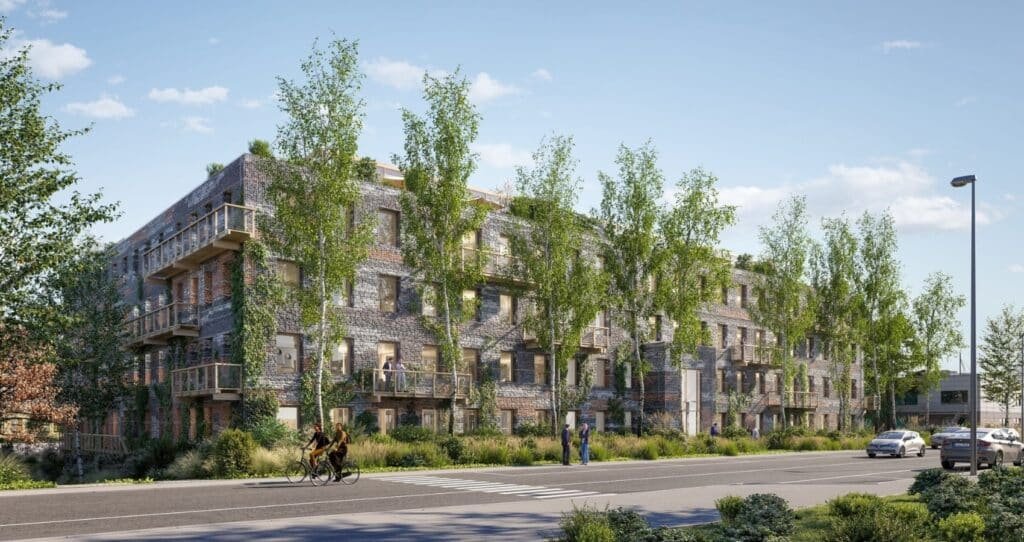Interview with Édouard François, architect, and Matthieu Leyder, Project Director The Nest at Eaglestone.
Designed by Maison Edouard François, a pioneering green architecture practice, and managed by developer Eaglestone Luxembourg, The Nest project will soon see the light of day at La Cloche d'Or. As well as placing the emphasis on biodiversity, the designer and developer have given in-depth thought to how to integrate the notion of eco-circularity into this office building.
Mr François, how have you addressed the issue of the circular economy in The Nest project?
Édouard François : It's like a multi-faceted ball, with all the facets interconnected and all playing together to make sense. Which makes the designer's job interesting.
As far as the reuse and recycling of materials is concerned, we have, from the outset, come up with a number of innovative solutions. gabion facades. This was linked to a strong desire on Eaglestone's part to construct a building that takes an interest in biodiversity. Biodiversity likes porosity and humidity, the complete opposite of a smooth glass façade that is constantly cleaned and lifeless. In these gabions, we will be able to introduce various reused elements - brick, concrete, stone, ceramics, etc. - to obtain a coloured result, which is very interesting in terms of its appearance, and which absolutely could not be obtained with industrial materials. A number of non-visible elements, such as false floors and visible elements such as parquet flooring, can also come from the demolition. You have to be open-minded enough to be able to seize the opportunity to salvage elements when the time comes. This requires agility, because you can't place orders like in industry.
Matthieu Leyder : There's a difference between reuse and recycling. Recycled glass, for example, is produced from crushed glass and then remelted. So it goes through a process that consumes energy, whereas if you reuse a glass element as it is in another project, you eliminate this energy production. Recycling is all very well, but reuse is even better because it reduces CO2 emissions.
For the gabion façades of The Nest, we're somewhere between reuse and recycling. We're going to work with demolition companies and target materials from buildings close to the site to limit transport, and these materials will be crushed and recalibrated.
We also know that the best possible reuse is contextual reuse. However, our project is located on a car park, which severely limits the possibilities for reusing materials directly in situ. We looked into the possibility of cutting the asphalt into strips to fill the gabion cages, but unfortunately we came up against difficulties due to the flammable and polluting compounds in this material. So it's not always easy to put in situ reuse into practice.

As well as the construction itself, have you applied the principles of eco-circularity to the furniture?
EF : We could also use furniture with a history which will contribute to the building's thickness, depth and fatness, notions that have been completely lost in a construction industry that could be described as anorexic, given its use of filmy, uneventful, low-grade materials. It is important to " twister "Eaglestone and I have this desire, while of course remaining within the limits of what offices are capable of accepting in order to guarantee their functionality and quality. Eaglestone and I have this desire, while of course remaining within the limits of what offices are capable of accepting in order to guarantee their functionality and quality. It's not a question of making a militant indictment, but I think we'll go far enough.
ML : We also recover technical equipment and sanitary appliances that may be in good condition. We select them according to the spaces where they could be installed in the future building, in particular by ensuring that they meet the technical and performance requirements for managing energy consumption. But to achieve this, we need to change the way people think.
Is the transition to circular models a question of mentality?
ML The mindset of all those involved in construction needs to change: suppliers, contractors, developers, future occupants and insurers. For suppliers and companies, because it requires extra work in terms of research, storage, handling and processing. Future occupants will also have to accept that the furniture is re-used, or that the tiles in the bathrooms of the 1er and 2e floors, for example. It's hard to find 500 m2 of identical tiles, so you have to work in smaller batches and plan accordingly. Lastly, insurers have to play their part to ensure that the chain is not broken. It is very rare, for example, to find products with their technical data sheet in the re-use sector. However, certain products in a batch can be tested to ensure that they are in good condition and have the characteristics required to benefit from traditional guarantees.
What does eco-circular construction mean for planning?
ML The planning has to be done much further upstream. For The Nest, we'll draw up a list of all the materials that could be reused, and then we'll have to find supply subsidiaries. This work can take months or even years. We have to target the buildings that are going to be demolished in advance, so that we can introduce into the new project elements of the same dimensions as those that can be recovered. It also means that we have to redefine our schedules and financial flows, so that if necessary we can buy certain stocks of materials from a re-use channel (very) far in advance.
What about the cost of reused or recycled materials?
ML : The aim of re-use in the building industry is not to reduce economic value. In reality, the cost of storage and repair is the same as for new materials. The longer a material is stored, the higher its cost of supply will be, and the financial balance may well become unworkable.

